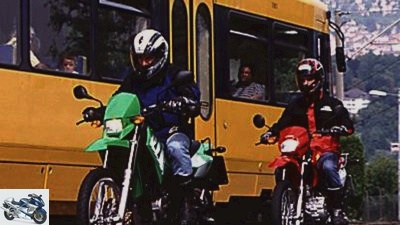Menus

Jahn
Comparison test between the Honda XR 125 L and the MZ 125 SX
New times
Cheap Honda versus expensive MZ, ancient engine from Japan versus high-tech four-valve engine from Saxony. Who would have thought that such a comparison test would one day?
The truth is already in the vehicle registration documents: under number six, maximum speed, you can find 100 km / h on the Honda XR 125 L and on the MZ 125 SX 110. No less interesting: power and maximum torque. The Honda is there too
their eleven hp and ten newton meters compared to the 15 hp and twelve newton meters of the MZ. Aha: Almost 30 percent more power
result in ten km / h more top speed. victory
for MZ. Or? But wait: Often times
the differences in driving operation are less than what the key performance data suggest. So get on the machines and experience the differences.
The MZ driver finds the choke-
Lever on the handlebar, the XR pilot has to fiddle with the carburetor. It starts at
both comfortably with an electric starter. The Honda man, sitting at a height of 83.5 centimeters, looks up at his MZ colleague, who is four centimeters higher. Where should it go? Opposite direction, turn once. Said and done. The 125cc SX starts up cleanly and thanks to the wide
Maneuver the handlebar and the relaxed seating position with ease.
Uncool, however, the XR. The Honda has a weak starting point, struggles slowly up to speed and stalls quickly. Means: Long dragging clutches and high speeds are the order of the day when driving off. In addition, even smaller drivers with elbows and upper bodies come up against tight turning maneuvers
in the way. This is their fault
Handlebars cranked back too much
and the seat recess that the pilot does not
give the opportunity to sit a little further back. If the intended direction is taken, however, the Honda will follow the MZ with ease through city traffic.
The air-cooled XR engine feels a little tougher than its livelier, water-cooled competitor, but it does more in the middle speed range. On top of that, the MZ has much longer breath. So with the
Honda more often tried the five-speed gearbox. Fortunately, this works just as easily with her as with the MZ 125 SX. But with the little Japanese, the connection to the next gear is not as seamless as with the MZ six-speed gearbox because of the larger gear ratio steps.
Thanks to their downright playful maneuverability, the two lightweights are great fun in the city. The long-legged MZ one more trick than
the Honda, because on it you can still look over cars that are on the much lower XR
already has to stretch his neck. But more foresight wouldn’t be bad,
because sudden braking is not the
Domain of the XR are. Her front brake grabs the disc neatly, but all in all it pays off
Honda triggers because their fork, which is too softly tuned, sometimes punctures when braking hard and the thin stanchions twist due to the load from the individual disc. The rear drum brake also got quite snappy. It tends to block or not to brake at all.
The rear disc brake of the SX is completely different. It is superior to the XR drum in every way. The front stopper of the MZ cannot stand out quite so clearly. The braking effect is at Honda level, but with frequent hard decelerations it tends to fade. However, since the fork is much more tightly tuned and therefore does not dip that far when suddenly throwing anchor, you feel safer on the MZ.
But enough of the city traffic, now it’s up to the country road. Gas on. They can finally show what
have them when you let them off the leash. 60, 70, 80, 90 … The MZ
the Honda has already driven away several meters, the distance increases. The XR is struggling to even reach its stated top speed of 100 km / h.
The SX, on the other hand, continues to spin happily and only stops at tachometer 120. The only point of criticism: the restless chassis. From around 70 km / h the MZ begins to oscillate around the steering axis as soon as it receives stronger impulses. Whether bumps across the road, a gust of wind from the side or a slightly harder gear change, the 125cc acknowledges it with nervous movements, which, however, always remain manageable. And you are compensated with an engine that lets the SX, which weighs 128 kilograms, always overtake the XR. Unless it is in sixth gear, which is far too long. Then it can happen that the Zschopau bike loses speed and the Japanese woman appears again in the rear-view mirrors, filling the format.
Not exactly suspicious for a design award, but the instruments of the opponents are sufficient. However, the MZ trip meter can only be read when the driver leans forward. In doing so, he might also like to briefly lift his troubled backside from the bench, which is indeed with a non-slip-
covered, but too narrow and soft for longer distances.
Although the XR bench was also a bit too soft and its cover offers little support, you can endure it longer because of the significantly wider seat cushion.
The last discipline for the cheeky 125cc: off to the ground. After all, the SX is touted as the “king of the sand track”, and according to Honda advertising, the XR should also “feel comfortable on bumpy paths off the beaten track”. The differences
in advertising roughly reflect the conditions in the quarry. You can have fun there with the Honda
as long as you get used to the unusual seating position and don’t ask too much of the soft chassis, especially the quick-acting shock absorber. There is nothing to adjust anyway.
With the MZ, the spring base of the shock absorber is adjustable. The fork and shock absorber offer significantly more reserves. In addition, the 125 SX from its powerful and agile engine. The upright seating position is good for off-road terrain, after all, MZ has had a long off-road experience. The only thing missing is an engine guard.
Buy complete article

Comparison test between the Honda XR 125 L and the MZ 125 SX
New times
Technical data: Honda XR 125 L
Engine: air-cooled single-cylinder four-stroke engine, an overhead, chain-driven camshaft, two valves, wet sump lubrication, round slide carburetor, Ø 22 mm, transistor ignition, no exhaust gas purification, electric starter. Bore x stroke 56.5 x 49.5 mm, displacement 124 cm3, nominal output 8, 3 kW (11 PS) at 8500 rpm Max. Torque 10 Nm (1.0 kpm) at 7000 rpm Pollutant values (homologation) CO 10.50 g / km, HC 0.95 g / km, NOx 0.19 g / km Power transmission: mechanically operated multi-disc oil bath clutch, five-speed gearbox, roller chain. Chassis: single-loop frame made of tubular steel, with split beams, telescopic fork, stanchion diameter 31 mm, two-arm swing arm made of steel profiles, central spring strut, directly hinged, front disc brake, Ø 240 mm, double-piston caliper, rear drum brake, Ø 110 mm. Tires 90 / 90-19; 110 / 90-17 Tires in the test Pirelli MT 60 Chassis data: wheelbase 1350 mm, steering head angle 64.3 degrees, caster 89 mm, spring travel f / r 180/160 mm. Dimensions and weights: seat height * 835 mm, weight with a full tank * 130 kg, payload * 158 kg, tank capacity / reserve 12.0 / 4.1 liters, test consumption * 3.4 l / 100 km. Two-year guarantee with no mileage limitColours red, blackPrice 2890 euros Additional costs 170 euros
Technical data: MZ 125 SX
Engine: water-cooled single-cylinder four-stroke engine, a balance shaft, two overhead, chain-driven camshafts, four valves, bucket tappets, wet sump lubrication, Mikuni round slide carburetor, Ø 24 mm, transistor ignition, no exhaust gas purification, electric starter.Bore x stroke 60 x 44 mm, displacement 124 cm3, rated output 11 kW (15 PS) at 9000 rpm Max. Torque 12 Nm (1.2 kpm) at 8500 rpm Pollutant values (homologation) CO 5.42 g / km, HC 0.62 g / km, NOx 0.15 g / km Power transmission: mechanically operated multi-plate oil bath clutch, six-speed gearbox, O- Ring chain. Chassis: single-loop frame made of tubular steel, open at the bottom, load-bearing motor, telescopic fork, standpipe diameter 36 mm, two-arm swing arm made of steel profiles, central spring strut, directly hinged, adjustable spring base, front disc brake, Ø 280 mm, double-piston caliper, rear disc brake, Ø 220 mm Single piston caliper. Tires 90 / 90-21; 120 / 80-18 Tires in the test Heidenau K60 Enduro Chassis data: wheelbase 1440 mm, steering head angle 64.5 degrees, caster 73 mm, spring travel f / h 220/220 mm. Dimensions and weights: seat height * 875 mm, weight with a full tank * 128 kg, payload * 192 kg, tank capacity / reserve 12.5 / 3.6 liters, test consumption * 3.8 l / 100 km. Two-year warranty with no mileage limitColours green, red, blackPrice without additional costs 3690 euros
Related articles
-
Comparison test of travel enduros
Jahn comparison test of travel enduros, BMW F 650 GS, Honda Transalp, Kawasaki Versys 650, Suzuki V-Strom 650 / XT We are then away towpath instead …
-
Comparison test BMW R 850 R against Ducati Monster 800s i.e.
Artist Comparison test BMW R 850 R against Ducati Monster 800s i.e. racoon Washboard In case of doubt, between 70 and 73 hp is worlds apart. Do not you…
-
duke Top test Honda CB 1300 Concentrated load 116 hp, 117 Newton meters. Power and torque complement each other practically one to one in the Honda CB…
-
Comparison test of the 650 all-rounder
Weihs Comparison test of the 650 all-rounder He and her and 1000 questions As a hot new addition, the Kawasaki ER-6n enriches the bare middle class….
-
Artist Concept comparison Enduros: BMW R 1150 GS, Honda XL 650 V Transalp, KTM LC 4 625 Supercompetition, MZ Baghira Enduro, Suzuki DR-Z 400 S Dream of…
-
Artist Top test Honda Hornet 900 That stings Low weight, good brakes, a powerful super sports engine: proven ingredients for a sporty naked bike. This…
-
Gargolov comparison test travel enduro bikes: Aprilia ETV 1000 Caponord, BMW R 1150 GS, Honda Varadero 1000, Suzuki DL 1000 V-Strom, Triumph Tiger 955i …
-
Gargolov comparative test Nurburgring To hell and back Nurburgring, Nordschleife. 94 curves, 46 crests, four super athletes and a greenhorn. A…
-
Comparison test of naked bikes with ABS
fact comparison test of naked bikes with ABS Veni, vidi, vici! In comparative tests and approval numbers, the all-rounders Honda CBF 600, Kawasaki ER-6n …
-
Comparison test Honda Fireblade, VTR 1000 SP-2
Artist Comparison test Honda Fireblade, VTR 1000 SP-2 Everything stays different Honda is the only motorcycle manufacturer to build two 1000cc super…